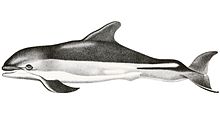Atlantic White-sided Dolphin
| Atlantic white-sided dolphin | |
|---|---|
 |
|
 |
|
| Size compared to an average human | |
| Scientific classification | |
| Kingdom: | Animalia |
| Phylum: | Chordata |
| Clade: | Synapsida |
| Class: | Mammalia |
| Order: | Artiodactyla |
| Infraorder: | Cetacea |
| Family: | Delphinidae |
| Genus: | Lagenorhynchus |
| Species: | L. acutus |
| Binomial name | |
|
Lagenorhynchus acutus (Gray, 1828) |
|
 |
|
| Atlantic white-sided dolphin range | |
The Atlantic white-sided dolphin (Lagenorhynchus acutus) is a distinctively coloured dolphin found in the cool to temperate waters of the North Atlantic Ocean.
The Atlantic white-sided dolphin was named by John Edward Gray in 1828. The specific name acutus comes from the Latin for 'pointed' and refers to the sharply pointed dorsal fin. L. acutus is one of six oceanic dolphins in the genus Lagenorhynchus.
The dolphin is slightly larger than most other oceanic dolphins. It is just over a meter in length at birth, growing to about 2.8 m (9.2 ft) (males) and 2.5 m (8.2 ft) (females) at maturity. It weighs 200–230 kg (440–510 lb) once fully-grown. Females reach sexual maturity at between 6 and 12 years, and males between 7 and 11 years. The gestation period is 11 months and lactation lasts for about a year and a half — both typical figures for dolphins. Individuals are known to live for up to 22 years (males) and 27 years (females).
The key distinguishing feature is the white to pale yellow patch found behind the dorsal fin of the dolphin on each side. This colour variation is unique amongst the mixtures of white, greys and blues of other pelagic cetaceans. The rest of the body's coloration is well demarcated: the chin, throat and belly are white; the flippers, dorsal fin and back are dark grey to black with the exception of the yellow patch; there is a further white patch below the dorsal fin, lying above a light grey stripe that runs from the beak, above the eye and down to the tail stock.
Dolphin group sizes vary by location, with groups averaging 60 in number close to the Newfoundland shores, but rather smaller east of Iceland. From the analysis of the stomach contents of stranded animals, fish such as herring and mackerel and squid appear to form the species' main diet. The Atlantic white-sided dolphin is fairly acrobatic and keen to interact with boats, however it is not as wildly gregarious as the white-beaked and common dolphins.
...
Wikipedia

